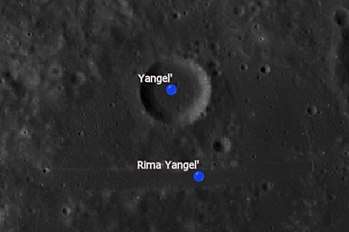Yangel'
 Lunar Orbiter 4 image | |
| Coordinates | 17°00′N 4°42′E / 17.0°N 4.7°ECoordinates: 17°00′N 4°42′E / 17.0°N 4.7°E |
|---|---|
| Diameter | 8 km |
| Depth | 0.4 km |
| Colongitude | 355° at sunrise |
| Eponym | Mikhail K. Yangel' |
Yangel' is a small lunar impact crater that is located in the irregular terrain to the north of the Mare Vaporum.
Just about 130 km west is the lunar Prime Meridian. Also the sun rises just before or after the third quarter of Earthshine and the sun sets just before its first quarter.
Description
Its diameter is about 8 km and its depth is around 400 meters. It is a relatively solitary crater formation, and the nearest larger craters lie more than 100 kilometers distant. To the southeast of Yangel' is the prominent crater Manilius. Conon is located to the northwest, near the flanks of the Montes Apenninus range.

Just to the north of Yangel' is the small lunar mare named Lacus Felicitatis, or Lake of Happiness. To the northeast, forming a bay on the Mare Vaporum, is Sinus Fidei. A sinuous rille named Rima Conon runs along the middle of this feature, reaching the northern end and another named Rima Yangel', a wider one runs east-west south of the crater.
This is a circular, bowl-shaped crater with a narrow outer rim. The interior floor has a relatively low albedo that matches the dark hue of the mare to the south.
Naming
The crater and the rille (rima) are named after Mikhail Kuzmich Yangel'.[1] This crater was formerly designated Manilius F before being given a name in 1973 by the IAU.[1] The rille was named by the IAU in 1978.[1]
Notes
References
- Andersson, L. E.; Whitaker, E. A. (1982). NASA Catalogue of Lunar Nomenclature. NASA RP-1097.
- Blue, Jennifer (July 25, 2007). "Gazetteer of Planetary Nomenclature". USGS. Retrieved 2007-08-05.
- Bussey, B.; Spudis, P. (2004). The Clementine Atlas of the Moon. New York: Cambridge University Press. ISBN 978-0-521-81528-4.
- Cocks, Elijah E.; Cocks, Josiah C. (1995). Who's Who on the Moon: A Biographical Dictionary of Lunar Nomenclature. Tudor Publishers. ISBN 978-0-936389-27-1.
- McDowell, Jonathan (July 15, 2007). "Lunar Nomenclature". Jonathan's Space Report. Retrieved 2007-10-24.
- Menzel, D. H.; Minnaert, M.; Levin, B.; Dollfus, A.; Bell, B. (1971). "Report on Lunar Nomenclature by the Working Group of Commission 17 of the IAU". Space Science Reviews. 12 (2): 136–186. Bibcode:1971SSRv...12..136M. doi:10.1007/BF00171763.
- Moore, Patrick (2001). On the Moon. Sterling Publishing Co. ISBN 978-0-304-35469-6.
- Price, Fred W. (1988). The Moon Observer's Handbook. Cambridge University Press. ISBN 978-0-521-33500-3.
- Rükl, Antonín (1990). Atlas of the Moon. Kalmbach Books. ISBN 978-0-913135-17-4.
- Webb, Rev. T. W. (1962). Celestial Objects for Common Telescopes (6th revised ed.). Dover. ISBN 978-0-486-20917-3.
- Whitaker, Ewen A. (1999). Mapping and Naming the Moon. Cambridge University Press. ISBN 978-0-521-62248-6.
- Wlasuk, Peter T. (2000). Observing the Moon. Springer. ISBN 978-1-85233-193-1.
External links
| Wikimedia Commons has media related to Yangel (crater). |